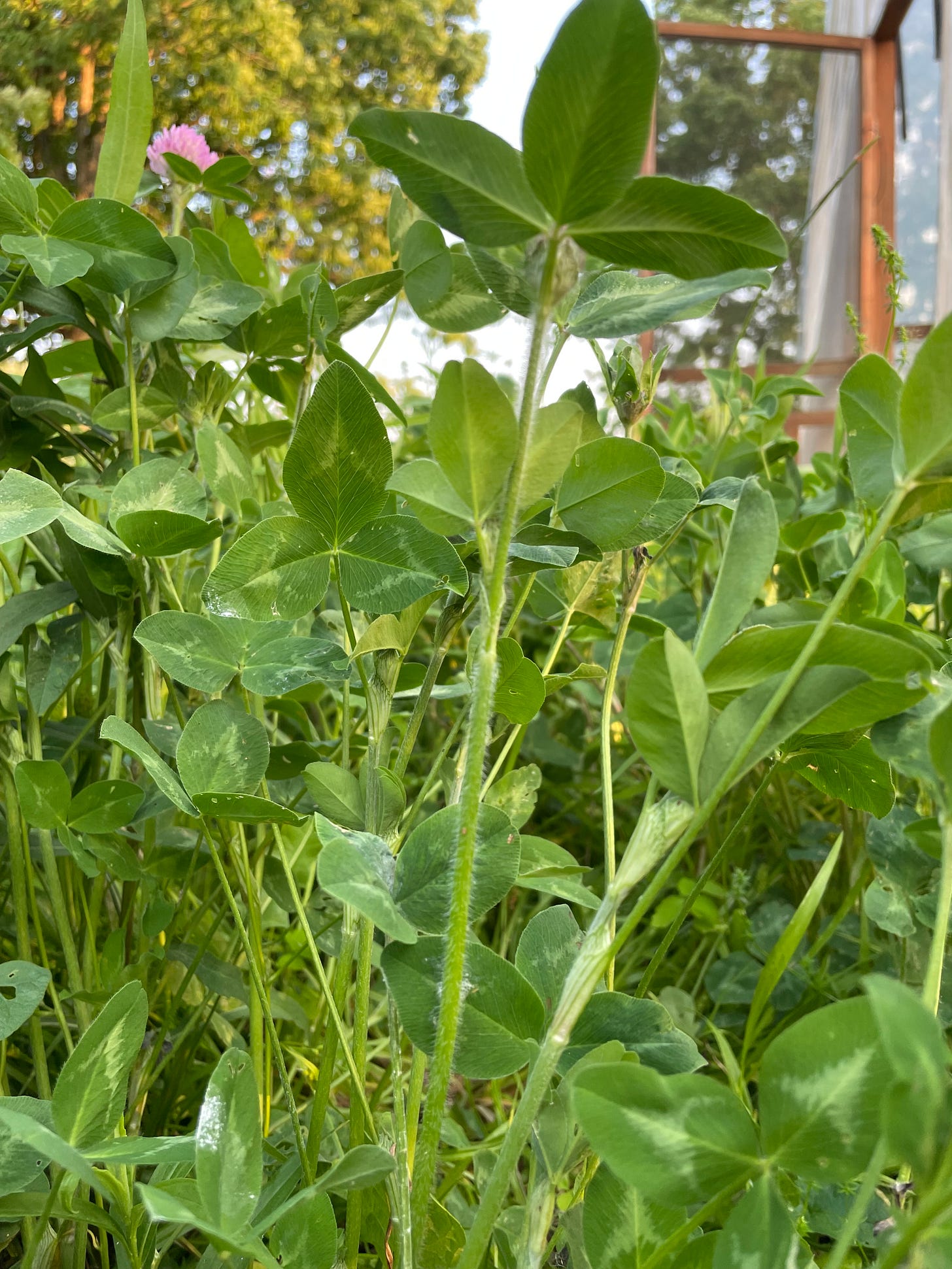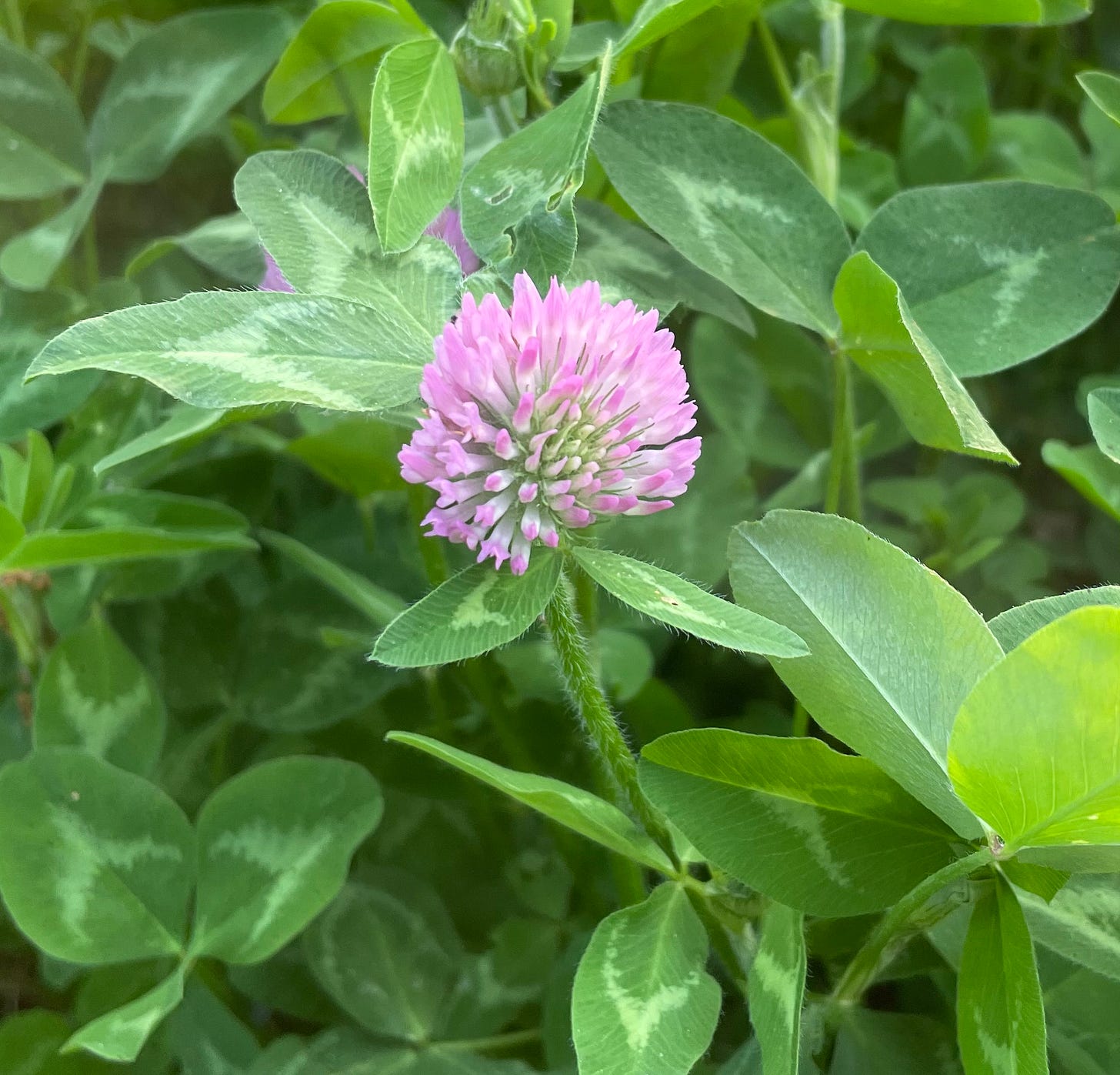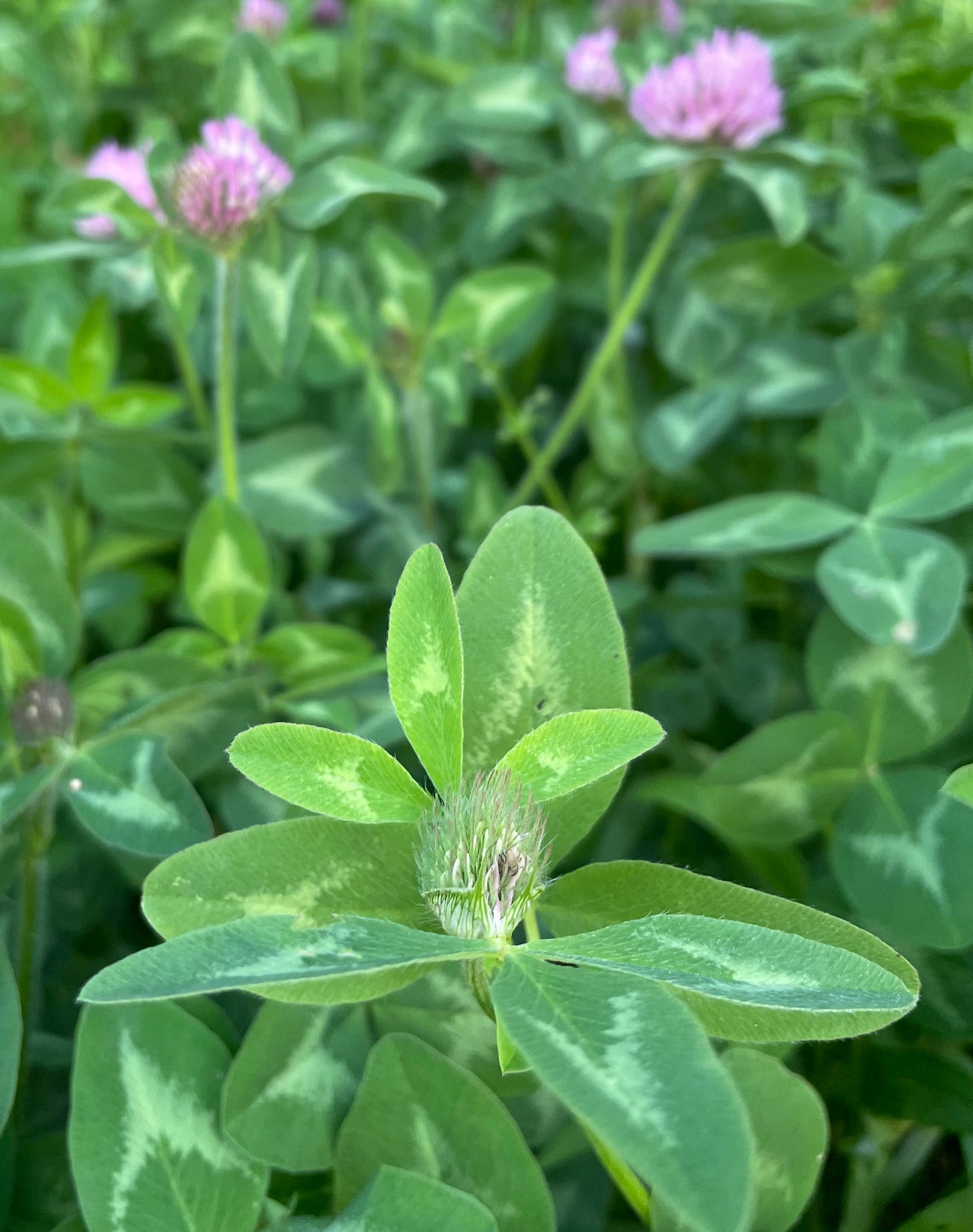These are the big, juicy clover plants with purply pink (Not Red) flowers that taste so sweet. The three leaves show a distinct chevron pattern which makes this plant so easy to identify. As a member of the legume family (Fabaceae) it feeds the livestock at the same time it replenishes the soil by nitrogen fixation. Although there are complaints about red clover, Trifolium pratense, being invasive, there is a genuine need for it to feed livestock and for crop rotation. This weed is one of the Creator’s multitaskers. Soy and various other beans are members of the same nitrogen fixing family.
Young leaves are edible, and so are the flowers. Red clover is in full bloom at weedom and we’re collecting some flower heads for tea.
Like soy, this plant is packed with isoflavonoid compounds which include the phytoestrogens. Soy-boy jokes aside, all humans have estrogen receptors which need to be activated for the necessary development and regulation of tissues throughout the body, including the brain. The sexes differ in what the 3 main types of estrogen receptors act on, as well as the interplay with testosterone activity, the pituitary and the structure and cycling of the hypthalamus.
Research on red clover in humans has been mostly about suppressing the hot flashes. This was inspired by the need for safer alternatives to estrogen use in post menopausal women. However there has been a rich history of traditional uses for this weed as a sedative, a nutritive, alterative, to purify the blood, suppress coughs and address respiratory issues, to treat skin issues such as eczema and psoriasis, to promote wound healing, to improve particularly peripheral circulation, for drainage of swollen glands and for lymphatic congestion, for mastitis, and as an antispasmotic. Topically and orally red clover has been used to address cancer, usually with the expectation to slow growth rather than cure. Trifolium pratense is among the top herbs used in midwifery to promote fertility. This is a bit of a paradox considering the manner in which the phytoestrogens are thought to operate. This plant has has a birth control type of effect on sheep if they consume large amounts.
Some alternative names for this weed are trifoil, cow grass, pea vine, and purple clover. Focusing on weed identification, forget the red part of the red clover name, and look for rounded heads full of blossoms ranging from pink to purply pink, which can be up to an inch, (2.5cm) in diameter. Each flower head is made up of numerous tubular flowers, each of which have 5 narrow petals. These flowers have a mild, sweet honey like smell, and we have noticed that the bumblebees will work on these more, while the honeybees seem to work the lower growing white clover, Trifolium repens. Flowers dry to a papery light brown, with seed pods containing tiny purple to brown hard seeds, which can survive passage through the digestive tracts of livestock, and be spread when they come out the other end.
The leaves are arranged alternately on the stem, and exist as a compound of three leaflets, each of which is about 3/4 inch wide by 2 inches long (~2cm x 5 cm). The individual leaflets have pinnate arrangement of veins, and their edges can appear smooth, or minutely serrated with hairs present. The entire plants can reach a 1/2 to 3/4 meter (18-24 inches) in height, though a good heavy rain can flatten them quite a bit. They have a biennial to perennial habit, depending on climate. Some varieties can produce stolons, horizontal stems that root into the ground to aid the spread of the plants. Red clover is native to Europe, Asia and Africa, but is widely naturalized in temperate parts of the world, growing in zones 3a to 9b.
Warnings not to use late summer plants come from the possibility that a fungus Rozoctonia leguminicola can infect the plant. This fungus produces a mycotoxin, indolizidine alkaloid called slaframine, that stimulates the salivary glands and pancreas to secrete excessively. Livestock consuming the late summer plants may exhibit the slobbers, and diarrhea, which can become severe and affect health seriously. Suffocation and death is possible, with horses being more susceptible. Storage of hay seems to cause this toxin to dissipate a great deal, but limiting the grazing on late summer red clover is advisable, as well as avoiding any of the black spotted plants for medicine.

The leaves of Red clover in Spring, before flowering are a salad green for us, and the flowers are edible too. Medicinally, the flowers are the most used part, although root infusions have been rarely applied externally on skin ulcers. A tea or tincture can be made of the fresh flowers, and they are often dried for teas and infusions. In general, the dose used to relieve hot flashes is higher than the amount used chronically to mitigate other menopausal issues such as bone loss. Some research indicates that the isoflavanoid containing extract of this herb showed positive effect on bone density after a 12 month period, though a short term 12 week study showed no significant effect. The main isoflavanoids studied are biochanin A, formononetin, daidzein, genistein, which can comprise up to 1 percent of the dried product of Trifolium pratense leaves stems and flower heads. . The yield of the flowers alone is lower, up to 0.28%. 40 to 120mg isoflavanoid doses have been studied for menopausal symptoms, including hot flashes. The dried material that needs to be extracted for 80mg of isoflavonoids is 8 grams of whole dried plant or 28 grams of whole dried flowers. Dose sizes for some other uses recommended by herbalists are mostly commensurate with that range
Studies of red clover for menopausal symptoms have produced inconsistent results for various reasons, some of which could be improved experimentally, and some which are difficult to overcome. These phytoestrogenic compounds are metabolized in the gut. Many of them can exist as glycosides in the plant or extract and flora of the gut breaks them down to the aglycone that can then be absorbed. Gut flora also metabolize biochanin A to genistein and formononetin to daidzein, which are the more active phytoestrogens. About a third of people have gut flora that can metabolize daidzein to equol, which is a more potent antioxidant and anti-androgen. Therefore, it will always be the case that specified doses of red clover will help some people more than others with the travails of menopause. Phytoestrogens can have mild estrogenic effects in those who have no estrogen, and can act as estrogen antagonists if they are competing with existing estrogen. They are more like the selective estrogen receptor modulators, that act more predominantly on the beta estrogen receptors. They may play a role in apoptosis of hormone dependent tumors, and thereby inhibit proliferation of these cells. Some research indicates that this might be the case for prostate cancer.
We are left with the mystery of why our weed can be birth control for livestock, but used as a fertility med by midwives. It could be a matter of dose, and again, the gut flora, which in herbivores and particularly ruminants is equipped to tear up any glycosidic linkages. Metabolism specific to the animal itself might convert these compounds to more powerful analogs.
Another interesting molecule found in the sprouts of red clover, (as well as soy and alfalfa and kudzu) is coumestrol, which binds equally to alpha and beta estrogen receptors with strong affinity. There was worry that this molecule was sufficiently pro-estrogenic to induce growth in hormone dependent cancer in vitro. Instead, this molecule seems to inhibit a protein kinase, CK2, that is integral to cancer cell proliferation and to viral replication, and in certain neurodegenerative diseases. So this coumestrol could be utilized for all kinds of medical magic.
Remember earlier we mentioned the sedative use of red clover. Some researcher found that an extract of this plant showed affinity for delta and mu opiate receptors. Don’t tell anyone, or all the red clover will become illegal to grow, and those cows will be deprived of one of life’s little pleasures.
Our Trifolium pratense will deserve another post or two in the future, because there are more molecules and medicine to cover.
Meanwhile, the recommended ethanol strength for tincture is 40%, and use recently dried blooms. Pick blooms earlier in the day and dry them in the dark. They will make a great aqueous infusion, to enjoy as tea. We have also collected and dried the stems, and leaves plus flowers for tincture. That can be made in a 1 part dried plant to 5 parts (or less) ethanol by weight.
Leave us some comments or try out the Notes function in SubStack. There’s a lot of good stuff to be found in this readers’ universe.
Where we dig:
1. Nissan HP, Lu J, Booth NL, Yamamura HI, Farnsworth NR, Wang ZJ. A red clover (Trifolium pratense) phase II clinical extract possesses opiate activity. J Ethnopharmacol. 2007;112(1):207-210. doi:10.1016/j.jep.2007.02.006
2. A REVIEW ON CHEMICAL AND BIOLOGICAL ACTIVITY OF TRIFOLIUM PRATENSE. PharmaTutor. Accessed May 23, 2023. https://www.pharmatutor.org/articles/review-chemical-biological-activity-of-trifolium-pratense
3. Booth NL, Nikolic D, van Breemen RB, et al. Confusion regarding anticoagulant coumarins in dietary supplements. Clinical Pharmacology & Therapeutics. 2004;76(6):511-516. doi:10.1016/j.clpt.2004.08.023
4. Wang Y, Tang Y, Liu C, Shi C, Zhang Y. Determination and isolation of potential α-glucosidase and xanthine oxidase inhibitors from Trifolium pratense L. by ultrafiltration liquid chromatography and high-speed countercurrent chromatography. Medicinal Chemistry Research. 2016;25. doi:10.1007/s00044-016-1548-4
5. https://eticdata.com EBE. ER (ESTROGEN RECEPTOR). NuRCaMeIn. Accessed May 23, 2023. https://www.ub.edu/nurcamein/en/nuclear-receptors/er-estrogen-receptor/
6. Kanadys W, Barańska A, Błaszczuk A, et al. Evaluation of Clinical Meaningfulness of Red Clover (Trifolium pratense L.) Extract to Relieve Hot Flushes and Menopausal Symptoms in Peri- and Post-Menopausal Women: A Systematic Review and Meta-Analysis of Randomized Controlled Trials. Nutrients. 2021;13(4):1258. doi:10.3390/nu13041258
7. Factsheet - Red clover. Accessed May 23, 2023. https://keys.lucidcentral.org/keys/v3/pastures/Html/Red_clover.htm
8. Hutchens AR. Indian Herbalogy of North America. Shambhala; Distributed in the United States by Random House; 1991. https://openlibrary.org/books/OL1567124M/Indian_herbalogy_of_North_America
9. Brandli A, Simpson JS, Ventura S. Isoflavones isolated from red clover (Trifolium pratense) inhibit smooth muscle contraction of the isolated rat prostate gland. Phytomedicine. 2010;17(11):895-901. doi:10.1016/j.phymed.2010.05.006
10. Hoffmann D. Medical Herbalism: The Science and Practice of Herbal Medicine. Healing Arts Press; 2003.
11. (PDF) Volatile Constituents of Trifolium Pratense and T. Repens from N.E. Italian Alpine Pastures. Accessed May 23, 2023. https://www.researchgate.net/publication/26697390_Volatile_Constituents_of_Trifolium_Pratense_and_T_Repens_from_NE_Italian_Alpine_Pastures
12. Bernatoniene J, Kazlauskaite JA, Kopustinskiene DM. Pleiotropic Effects of Isoflavones in Inflammation and Chronic Degenerative Diseases. Int J Mol Sci. 2021;22(11):5656. doi:10.3390/ijms22115656
13. MNIMH DLHBsH. Red Clover. Healthy.net. Published August 26, 2019. Accessed May 23, 2023. https://healthy.net/2019/08/26/red-clover/
14. Red Clover. Blessed Maine Herb Farm. Accessed May 23, 2023. https://blessed-maine-herb-farm.myshopify.com/pages/red-clover
15. Red Clover Benefits & Information (Trifolium Pratense). Herbwisdom. Accessed May 23, 2023. https://www.herbwisdom.com/herb-red-clover.html
16. Red Clover: Supplement, Uses, Side Effects, Dosages, Interactions, Warnings. RxList. Accessed May 23, 2023. https://www.rxlist.com/red_clover/generic-drug.htm
17. DerMarderosian A, Buetler J. Review of Natural Products. 8th edition. Lippincott Williams & Wilkins; Facts and Comparisons; 2014. https://openlibrary.org/books/OL27960482M/Review_of_Natural_Products
18. Booth NL, Overk CR, Yao P, et al. Seasonal variation of red clover (Trifolium pratense L., Fabaceae) isoflavones and estrogenic activity. J Agric Food Chem. 2006;54(4):1277-1282. doi:10.1021/jf052927u
19. Arnold M, Smith SR. Slaframine Toxicosis or “Slobbers” in Cattle and Horses.
20. Booth N, Overk C, Yao P, et al. The Chemical and Biologic Profile of a Red Clover ( Trifolium pratense L.) Phase II Clinical Extract. Journal of alternative and complementary medicine (New York, NY). 2006;12:133-139. doi:10.1089/acm.2006.12.133
21. Booth NL, Overk CR, Yao P, et al. The Chemical and Biologic Profile of a Red Clover (Trifolium pratense L.) Phase II Clinical Extract. The Journal of Alternative and Complementary Medicine. 2006;12(2):133-139. doi:10.1089/acm.2006.12.133
22. Wood M. The Earthwise Herbal - A Complete Guide to Old World Medicinal Plants. North Atlantic Books; 2008. https://openlibrary.org/books/OL12031143M/The_Earthwise_Herbal
23. Easley T. The Modern Herbal Dispensatory - a Medicine-Making Guide.; 2016. https://openlibrary.org/books/OL26933940M/The_modern_herbal_dispensatory
24. Trifolium pratense. Accessed May 24, 2023. https://www.hort.purdue.edu/newcrop/duke_energy/Trifolium_pratense.html
25. Trifolium pratense (Cow Grass, Peavine Clover, Purple Clover, Red Clover) | North Carolina Extension Gardener Plant Toolbox. Accessed May 21, 2023. https://plants.ces.ncsu.edu/plants/trifolium-pratense/
26. Trifolium pratense (Red Clover): Minnesota Wildflowers. Accessed May 23, 2023. https://www.minnesotawildflowers.info/flower/red-clover
27. Figueiredo R, Rodrigues A, Doceucosta M. Volatile composition of red clover (Trifolium pratense L.) forages in Portugal: The influence of ripening stage and ensilage. Food Chemistry. 2007;104(4):1445.
28. Tava A, Ramella D, Grecchi M, Aceto P, Paoletti R, Piano E. Volatile Constituents of Trifolium Pratense and T. Repens from N.E. Italian Alpine Pastures. Natural product communications. 2009;4:835-838. doi:10.1177/1934578X0900400619
29. Cecotti R, Carpana E, Bergomi P, Tava A. Volatile Constituents of Trifolium pratense spp. nivale Quantified at Different Growth Stages, and Evaluation of their Antimicrobial Activity. Natural Product Communications. 2013;8(11):1934578X1300801131. doi:10.1177/1934578X1300801131






Now these I have seen even here, but only in one place: in an unmown nature strip behind Macquarie University Hospital. I wanted to get some flowers for my wife to try because she always gets digital ulcers.